
Breakneck Ridge station is a rail station on the Metro-North Railroad Hudson Line, serving campers and hikers traveling to and from Breakneck Ridge, in Fishkill, New York. Trains stop at the station on Saturdays, Sundays, and holidays only.

Manitou station is a limited-service stop on the Metro-North Railroad's Hudson Line. It serves the hamlet of Manitou in the southwestern corner of Philipstown in Putnam County, New York. The station is open part-time, serving one weekday peak hour train in each direction and six weekend trains each direction.
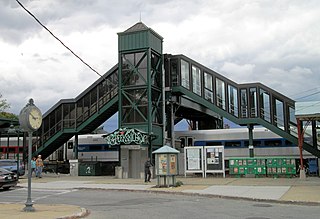
Peekskill station is a commuter rail stop on the Metro-North Railroad's Hudson Line, located in Peekskill, New York.
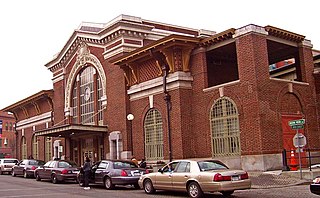
Yonkers station is a Metro-North Railroad and Amtrak railroad station located near Getty Square in Yonkers, New York. It is served by Metro-North Hudson Line commuter rail service and five Amtrak intercity services. The station building was constructed in 1911–1912, replacing an older structure.

Spuyten Duyvil station is a commuter rail stop on the Metro-North Railroad's Hudson Line, serving the Spuyten Duyvil neighborhood of the Bronx, New York City.

Wassaic station is a commuter rail stop on the Metro-North Railroad's Harlem Line, located in the town of Amenia, New York. It is the northern terminal of the Harlem Line.

Harlem Valley–Wingdale station on the Metro-North Railroad's Harlem Line, located in the Wingdale section of Dover, New York. It is adjacent to the site of the former Harlem Valley State Hospital.

Pawling station is a commuter rail stop on the Metro-North Railroad's Harlem Line, located in Pawling, New York.

Crestwood station is a commuter rail stop on the Metro-North Railroad's Harlem Line, serving the communities of Tuckahoe, Yonkers, and Eastchester, New York. Because of its location at the northern end of the triple-track segment of the Harlem Line, Crestwood is often the first/last stop outside New York City on Harlem Line express trains, and its center island platform is frequently used to short turn local trains during rush hour.
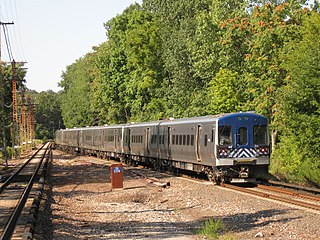
The Harlem Line is an 82-mile (132 km) commuter rail line owned and operated by the Metro-North Railroad in the U.S. state of New York. It runs north from New York City to Wassaic, in eastern Dutchess County. The lower 53 miles (85 km) from Grand Central Terminal to Southeast, in Putnam County, is electrified with a third rail and has at least two tracks. The section north of Southeast is a non-electrified single-track line served by diesel locomotives. Before the renaming of the line in 1983, it eventually became the Harlem Division of the New York Central Railroad. The diesel trains usually run as a shuttle on the northern end of the line, except for rush-hour express trains in the peak direction.
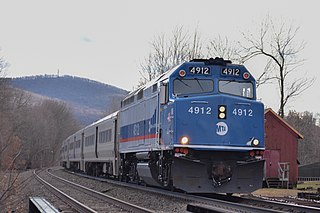
The Port Jervis Line is a predominantly single-track commuter rail line running between Suffern and Port Jervis, in the U.S. state of New York. At Suffern, the line continues south into New Jersey on NJ Transit's Main Line. The line is operated by NJ Transit Rail Operations under a contract with Metro-North Railroad (MNRR).

Pleasantville station is a commuter rail stop on the Metro-North Railroad's Harlem Line, located in Pleasantville, New York. There is also bus service to the station from Pace University.
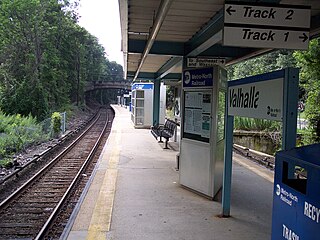
Valhalla station is a commuter rail stop on the Metro-North Railroad's Harlem Line, located in Mount Pleasant, New York.

Woodlawn station is a commuter rail stop on the Metro-North Railroad's Harlem Line, serving the Woodlawn section of the Bronx, New York City. It is located on East 233rd Street near Webster Avenue. Just north of the station is Woodlawn Junction, where the New Haven Line splits from the Harlem Line to join the Northeast Corridor.
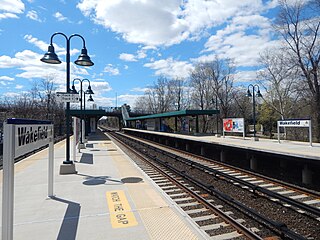
Wakefield station is a commuter rail station on the Metro-North Railroad's Harlem Line, serving the Wakefield section of the Bronx, New York City. The station is located on East 241st Street and is the northernmost stop in New York City on the Harlem Line.

Tuckahoe station is a commuter rail stop on the Metro-North Railroad's Harlem Line, located in the village of Tuckahoe, New York.

New Rochelle station is a Metro-North Railroad and Amtrak train station located in New Rochelle, New York. The station serves Metro-North's New Haven Line and Amtrak's Northeast Regional; Bee-Line Bus System buses serve a bus stop just outside the station. As of August 2006, weekday commuter ridership was 4,020, and there are 1,381 parking spots. It is the busiest New Haven Line station in Westchester County.

Harrison station is a commuter rail station on the Metro-North Railroad New Haven Line, located in Harrison, New York, United States. During peak hours, some local trains originate or terminate here as opposed to locals from Stamford. The station has two high-level side platforms, each 10 cars long, serving the outer tracks of the four-track Northeast Corridor.
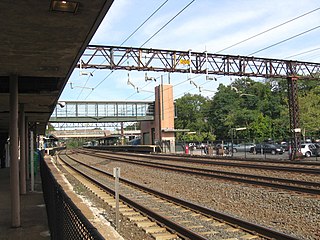
Rye station is a commuter rail stop on the Metro-North Railroad New Haven Line, located in the city of Rye, New York. The station has two side platforms, each ten cars long, serving the outer tracks of the four-track line.

Redding station is a commuter rail stop on the Danbury Branch of the Metro-North Railroad New Haven Line, located in Redding, Connecticut. The station has one two-car-long high-level side platform to the west of the single track.





















